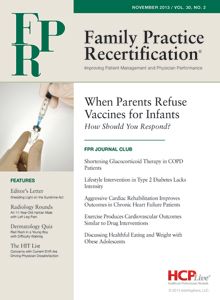Publication
Article
Family Practice Recertification
Shortening Glucocorticoid Therapy in COPD Patients
Author(s):
The REDUCE randomized clinical trial determined that 40 mg prednisone administered daily for 5 days wasn't inferior to 14 days of treatment in a placebo-controlled, double-blind setting.
Frank J. Domino, MD
Review
Leuppi, JD, et al. Short-term vs conventional glucocorticoid therapy in acute exacerbations of chronic obstructive pulmonary disease: The REDUCE randomized clinical trial. JAMA. 2013 Jun 5;309(21):2223-31. http://jama.jamane2rk.com/article.aspx?articleid=1688035.
Study Methods and Patient Demographics
The Reduction in the Use of Corticosteroids in Exacerbated COPD (REDUCE) study was a randomized, non-inferiority multicenter trial conducted at 5 Swiss teaching hospitals. The study enrolled 314 patients who presented to the hospitals’ emergency departments with acute chronic obstructive pulmonary disease (COPD) exacerbations who were past or present smokers for 20 or more pack-years without a history of asthma.
The goal of the REDUCE study was to determine if 40 mg prednisone administered daily for 5 days wasn’t inferior to 14 days of treatment in a placebo-controlled, double-blind fashion.
The primary endpoint was the amount of time until the next COPD exacerbation within the following 6 months. Secondary endpoints included all-cause mortality, change in forced expiratory volume in 1 second (FEV1), cumulative glucocorticoid dose, and clinical performance assessed through questionnaires from the Medical Research Council dyspnea scale, a bronchitis-associated quality-of-life (QOL) score, and patient-reported overall performance on a visual analog scale. All of those endpoints were assessed during initial exacerbation and throughout the 6-month follow-up period.
The researchers measured duration of hospital stay, time to open-label glucocorticoid therapy, and need for intubation or noninvasive ventilation during the index exacerbation, and they also tracked glucocorticoid-associated adverse effects, including new or worsened hyperglycemia.
Intervention and Control
To allow for the inclusion of those in respiratory distress, all patients received an initial dose of 40 mg intravenous methylprednisolone on day 1, followed by 40 mg oral prednisone daily through day 5. On day 6 through 14, patients received either 40 mg oral prednisone or placebo in daily doses.
Additionally, all patients received a broad-spectrum antibiotic for 6 days and an inhaled, nebulized, short-acting bronchodilator 4 to 6 times daily as needed while they were hospitalized. Throughout the study, inhaled glucocorticoids combined with inhaled long-acting beta 2-agonists were administered twice daily, as was once-daily 18 mg Spiriva (tiotropium bromide). Physiotherapy, supplemental oxygen, and ventilatory support were administered according to joint American Thoracic Society (ATS) and European Respiratory Society (ERS) guidelines. Additional glucocorticoids could be administered at the discretion of the treating physicians. During hospitalization, endpoints were assessed daily, as well as on days 6, 15, 30, 90, and 180.
Results and Outcomes
Of 314 randomized patients — 289 (92%) of whom were admitted to the hospital — 311 were included in the intention-to-treat analysis and 296 were enrolled in the per-protocol analysis.
Hazard ratios for the short-term steroid versus longer treatment group were 0.95 in the intention-to-treat analysis (90% confidence interval [CI], 0.70 to 1.29; P=.006) and 0.93 in the per-protocol analysis (90% CI, 0.68 to 1.26; P=.005), which met the study’s non-inferiority criterion.
In the short-term treatment group, 56 patients (35.9 %) reached the primary endpoint of repeat exacerbation, compared to 57 (36.8 %) in the conventional treatment group. Estimates of re-COPD exacerbation rates within 180 days were 37.2 % in the short-term group (95% CI, 29.5 to 44.9%) and 38.4% in the conventional group (95% CI, 30.6 to 46.3 %), which showed a slightly faster rate to re-exacerbation with a difference of 1.2 % between the 2 groups (95% CI, -12.2 to 9.8%).
Among patients with a re-exacerbation of COPD, the median time to the event was 43.5 days in the short-term treatment group (interquartile range [IQR], 13 to 118) and 29 days in the conventional treatment group (IQR, 16 to 85). Those in the shorter treatment group had an approximately one-day decrease in their length of hospital stay, though FEV1 and clinical performance survey results were equivalent among both groups.
There was no difference between the groups regarding time to death, recovery of lung function, the combined endpoint of COPD exacerbation, death, or both. Though the mean cumulative prednisone dose was significantly higher in the conventional treatment group compared to the short-term treatment group (793 mg [95% CI, 710 to 876 mg] versus 379 mg [95% CI, 311 to 446 mg], P< .001), treatment-associated adverse events — including hyperglycemia and hypertension — didn’t occur more frequently.
Conclusion
Five days of glucocorticoids therapy is just as effective as longer treatment courses for patients with COPD exacerbations.
Commentary
While there’s no clear data on the optimal dose and duration of glucocorticoids for COPD exacerbation, this study helps healthcare providers feel confident about prescribing a shorter duration of treatment when needed, and it does offer physicians a tangible dose and duration of glucocorticoid to use.
However, there are some parameters in the REDUCE study that should be considered and compared to the current standard of care when treating a COPD event, such as:
- Most of the study participants were in the moderate-to-severe stages of COPD, and all patients were either former or active smokers.
- Broad spectrum antibiotics were used in all patients, as were scheduled long-acting beta agonists, inhaled glucocorticoids, and tiotropium for the entire 6-month study period, which constitute a treatment approach that may be more aggressive than normal.
- The initial dose of glucocorticoid was administered intravenously in all patients.
Though this study encourages and reassures the safety of short-term use of glucocorticoids for acute COPD exacerbations, physicians should provide close follow-up monitoring to determine their patients’ risk of re-exacerbation, consider using inhaled agents and antibiotics, and never forget to ask smokers about their current interest in smoking cessation.
About the Author
Frank J. Domino, MD, is Professor and Pre-Doctoral Education Director for the Department of Family Medicine and Community Health at the University of Massachusetts Medical School in Worcester, MA. Domino is Editor-in-Chief of the 5-Minute Clinical Consult series (Lippincott Williams & Wilkins). Additionally, he is Co-Author and Editor of the Epocrates LAB database, and author and editor to the MedPearls smartphone app. He presents nationally for the American Academy of Family Medicine and serves as the Family Physician Representative to the Harvard Medical School’s Continuing Education Committee.






